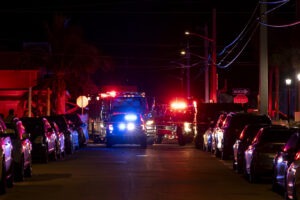
With eyes on water and on land, U.S. Coast Guard Station Islamorada also is taking to the sky, thanks to a program that’s introducing short-range drones.
On the grounds of Station Islamorada recently, Coast Guard members looking to become certified drone pilots grabbed handheld controllers during a three-day training with instructors. Launching the station’s two drones into the air, two instructors stood by trainees as they maneuvered drones over the waters, scouring the mangroves of Snake Creek and surveying the scene from above before bringing them back for landing.
Trainees had to obtain an FAA Part 107 license before receiving training and a remote pilot certification to fly missions with the Coast Guard. Three newly certified pilots are expanding the Unmanned Aircraft Systems (UAS) program in the U.S. and the Keys. Lt. Cmdr. Dominic Bucciarelli, program manager for the Coast Guard’s short range UAS, said the small drone introduction onto cutters and stations began in 2018, when authorization by Congress was given for their use by the Coast Guard. The intent of the program is twofold, he said.
“UAS can go into nooks and crannies and see things that crews normally can’t see. If a boat’s washed up, crews can shoot a drone straight across from their boat, see the tag numbers and contact the owner,” said Bucciarelli, who came down to the Keys from Department of Homeland Security headquarters in Washington, D.C. “It’s also offering us some civil engineering aspects. After a hurricane, we can do assessments a lot quicker instead of grabbing an expensive helicopter or plane.”
Seven units in the Coast Guard began using short-range drones during the start of the program three years ago. Today, Bucciarelli said, 35 out of some 400 Coast Guard units in the country have drone deployment capabilities. Before the training in Islamorada, Bucciarelli was in Seattle to introduce the short-range UAS.
“We don’t just let any unit come on,” he said. “We have each unit put in a request, and we see the geographic capability and if it will benefit them.”
Once the request is approved, trainees meet up with instructors at the station or another location. The training consists of presentations on policy for a day and two days of flight instruction. Bucciarelli said the training is hands-on.
“We get them out here and get them comfortable. We even put them in uncomfortable situations where they lose video feed just so they see what happens,” he said.
Among the instructors showing trainees how to launch and fly was Islamorada resident David Gross. A member of the U.S. Coast Guard Auxiliary Flotilla 13-8, Gross holds an FAA Part 107 drone pilot license and a Coast Guard SR-UAS pilot license. As a certified drone pilot, Gross has assisted Florida Fish & Wildlife Conservation and NOAA in derelict vessel cases and prop scarring incidents.
Gross flew a derelict mission with FWC and a mission with one of the Coast Guard’s newly-certified pilots on Dec. 1. Gross said he’s grateful for the opportunity to train those interested in wanting to fly drones. With Gross, Coast Guard Station Islamorada has four certified pilots to assist in missions.

“It’s a great morale booster when you’re able to bring new operators on board, and it serves for a good purpose,” Gross said. “For me, it’s a labor of love.”
Bucciarelli said having a local with high drone-flying expertise, like Gross, is exactly what the Coast Guard is seeking for when it comes to having instructors in different regions of the country. Matt James, commander of Station Islamorada, said it also shows the value of a Coast Guard Auxiliary to Coasties.
“There are skill sets they bring to the table that aren’t necessarily organic to us,” James said.
With drone-flying capabilities, James said, crews will have an easier time accessing parts of Florida Bay that are remote.
“This gives us the ability to get close by, put the UAS up and scout the mangroves and look beyond shallow spots,” he said. “It’ll make us more efficient and safer for our operators too. It’s hard to help folks if our boat is stuck in the mud.”
Offshore, James said use of drones will allow crews to look at objects quicker and move on to other searches.
“It gives us the capability of having two assets running patterns,” he said.
Use of short-range drones within the government have emerged over the years to support everything from firefighting and search and rescue to monitoring critical infrastructure — as Florida Department of Environmental Protection did in April to inspect the old 7-Mile and Bahia Honda bridges — and transportation of goods. Unmanned aircraft have grown so much interest that a bill introduced by U.S. Rep. Greg Stanton, of Arizona, in September is seeking to establish a drone infrastructure grant program for governmental entities for infrastructure projects. The bill, which seeks $50 million in fiscal year 2022 and 2023, was referred to the Subcommittee on Aviation.


























